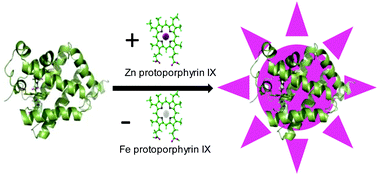Utility of fluorescent heme analogue ZnPPIX to monitor conformational heterogeneity in vertebrate hexa-coordinated globins†
Abstract
Here, we report the preparation and photo-physical characterization of hexa-coordinated vertebrate globins, human neuroglobin (hNgb) and cytoglobin (hCygb), with the native iron protoporphyrin IX (FePPIX) cofactor replaced by a fluorescent isostructural analogue, zinc protoporphyrin IX (ZnPPIX). To facilitate insertion of ZnPPIX into hexa-coordinated globins, apoproteins prepared via butanone extraction were unfolded by the addition of GuHCl and subsequently slowly refolded in the presence of ZnPPIX. The absorption/emission spectra of ZnPPIX reconstituted hCygb are similar to those observed for ZnPPIX reconstituted myoglobin whereas the absorption and emission spectra of ZnPPIX reconstituted hNgb are blue shifted by ∼2 nm. Different steady state absorption and emission properties of ZnPPIX incorporated in hCygb and hNgb are consistent with distinct hydrogen bonding interactions between ZnPPIX and the globin matrix. The fluorescence lifetime of ZnPPIX in hexa-coordinated globins is bimodal pointing towards increased heterogeneity of the heme binding cavity in hCygb and hNgb. ZnPPIX reconstituted Ngb binds to cytochrome c with the same affinity as reported for the native protein, suggesting that fluorescent analogues of Cygb and Ngb can be readily employed to monitor interactions between vertebrate hexa-coordinated globins and other proteins.



 Please wait while we load your content...
Please wait while we load your content...